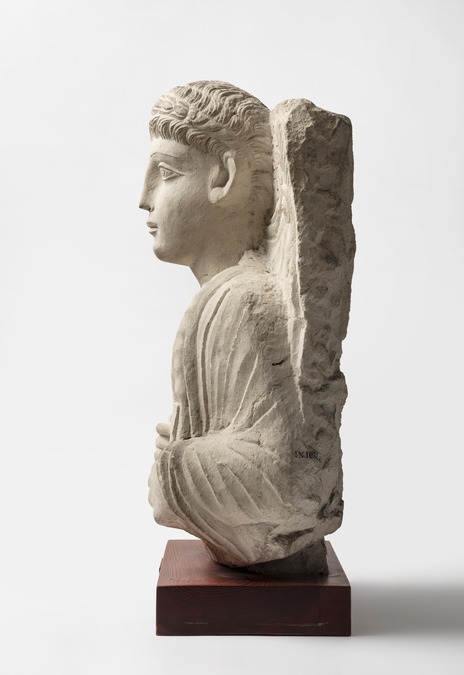Palmyrene loculus relief depicting a man
Summary
This relief is rectangular with a centrally-placed male bust. A man, Malkai, is portrayed on a grave relief from Palmyra, Syria. The object is well-preserved, only with small fragments missing from the edge. The portrait itself is well-preserved, only with two diagonal cracks running across the chest and neck and a fragment missing from the chin. A cloth is hanging behind him, which is pinned by two circular medallions from which two leaves rise vertically. A five-lined inscription, with traces of red pigment, is visible in the upper right corner.
Malkai is portrayed wearing a wreath around his head. Furthermore, he is wearing a tunic and a himation. He is holding a book-roll with his left hand.
Description of object
The relief is rectangular with a centrally-placed male bust. A man, identified as Malkai in the inscription, is portrayed on a loculus relief. The object is well-preserved, only with small fragments missing from the edge. The portrait itself is well-preserved, only with two diagonal cracks running across the chest and neck and a fragment missing from the chin. A cloth is hanging behind him, which is pinned by two circular medallions from which two leaves rise vertically. A five-lined inscription, with traces of red pigment, is visible in the upper right corner.
Malkai is depicted frontally, both with the arms bent, and held in front of the torso. He has a large head with wavy hair arranged in rich locks in a horizontal row across his forehead. Overall, his hair is arranged in three rows of crescent-shaped locks, alternating in direction by each row. Individual strands of hair can be seen, shown through incised lines. Atop his head, Malkai is wearing a wreath of leaves on his head, with the leaves pointing towards a central rosette. His forehead is protruding and his eyebrows are indicated by wide incisions. The eyelids are heavy. The eyes are large and the iris is indicated by an incised circle, while the pupils are indicated by a small depression. He has a long, narrow nose and his ears are slightly protruding with indication of helix and earlobes. The upper lip is wide and the lower lip is more narrow, but full. He has a wide chin. His ears are another notable feature; large, and protruding with the heliix, tragus, scapha, and earlobe carved into the stone. Malkai is wearing a long-sleeved tunic with a wide, rounded neckline with a scalloped edge. The folds of the tunic are indicated by ridges. He is also wearing a himation, which is wrapped around the lower part of his torso, covering the left shoulder and the left arm. The folds of the himation are indicated by ridges and a fold falling vertically from the left shoulder is rendered in a wavy look. The arms of Malkai are under proportioned and both are held in front of the torso. The fingers are flexed except from the index finger and the thumb, which are extended. The fingers of the left hand are also extended, except from the ring finger, which is slightly flexed. Fingernails are indicated. Malkai is holding a book-roll in his left hand between his index finger and his thumb.
Inscription: MLKY | BR | ʽTYʽ | QB | ḤBL
Malkai, son of ʽAtêʽaqab. Alas! CIS: 4390 PAT: 0749Choice of methods
Visual examination
- Macroscopic
Bibliography
Ingholt Archive
J.-B. Chabot (1922), Choix d’inscriptions de Palmyre, Paris, pl. XXVIII, no. 12.
M.A.R. Colledge (1976), The Art of Palmyra, London, 249.
H. Ingholt (1976), ‘Varia Tadmorea’, in E. Frézouls (ed.), Palmyre: Bilan et perspectives. Colloque de Strasbourg, 18-20 Octobre 1973, Travaux du centre de recherche sur le Proche-Orient et la Grèce antiques 3, 109.
F.O. Hvidberg-Hanse & G. Ploug (1993), Palmyra Samlingen, Ny Carlsberg Glyptotek, København, 91, no. 48.
S. Krag (2015), The secrets of the funerary buildings in Palmyra during the Roman period, in E. Mortensen & S.G. Saxkjær (eds.), Revealing and concealing in Antiquity. Textual and Archaeological Approaches to Secrecy, Aarhus, 109-110.
- IN 1052
- Portrait relief
- c. 150-170 C.E.
- Roman Imperial
- Limestone
- Acquired by Løytved in Syria. Original grave context unknown.
- H: 61 cm.; W: 48.5 cm.; D: 26 cm. Figure, H: 61 cm.; W: 48.5 cm.; D: 16 cm. Head, W: 19.5 cm.; D: 19 cm..; H: 22 cm.



